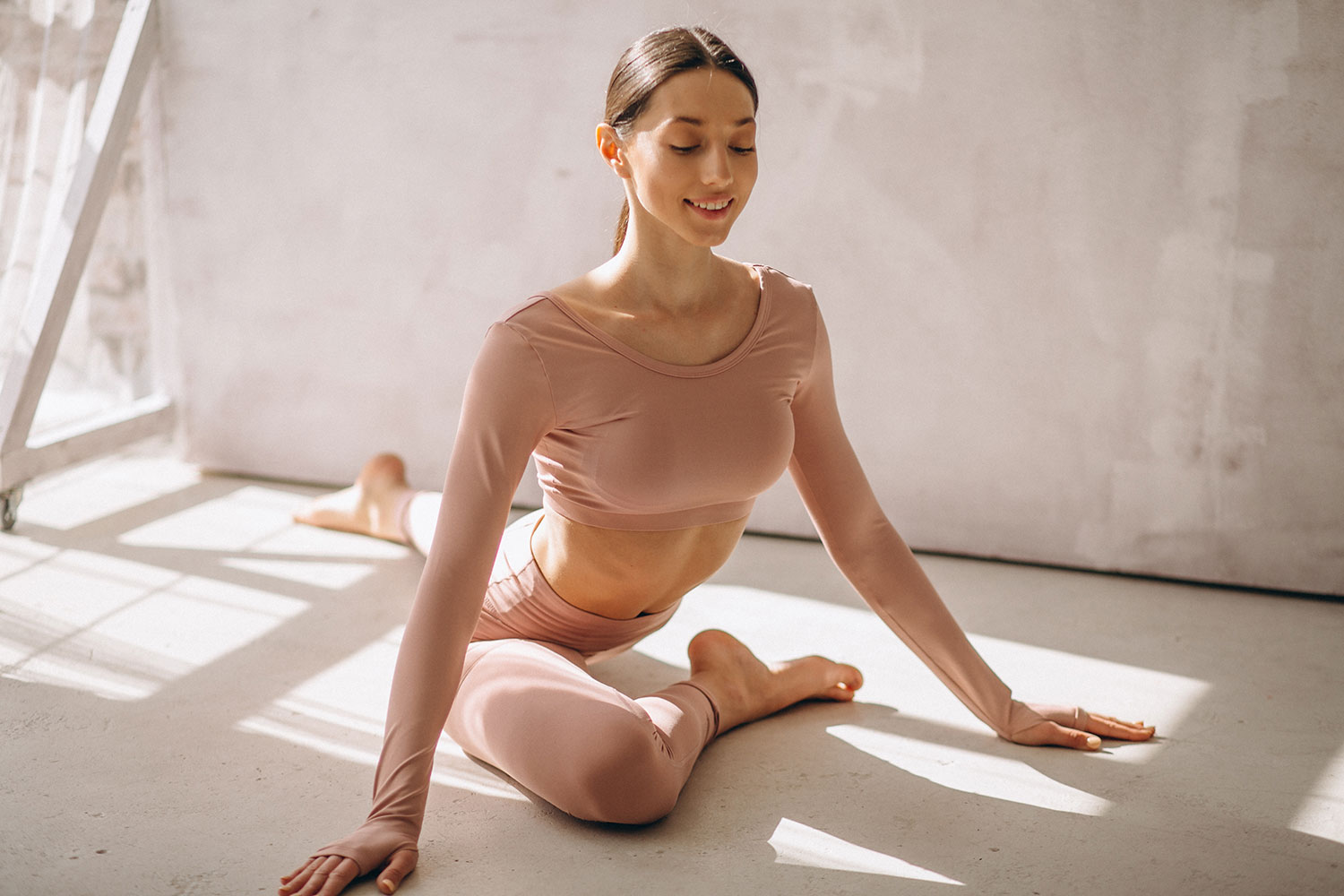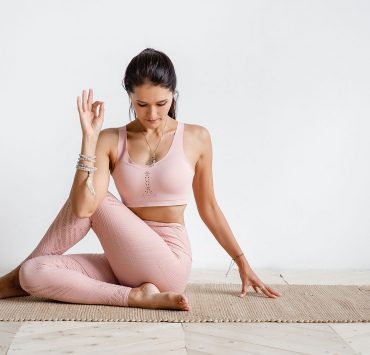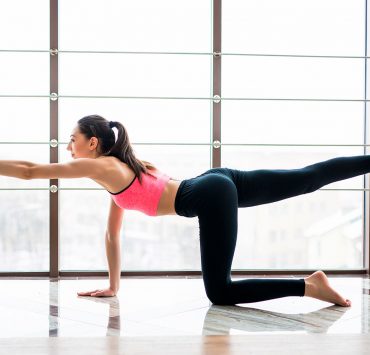
Having been a teacher’s assistant at over 50 yoga teacher…
It’s no secret that menstruation can come with some pretty uncomfortable symptoms. You might feel hotter than usual, get PMS, and of course, deal with painful period cramps. Thankfully, yoga, pranayama, and self-care practices can help ease period pain if not get rid of it completely.
Yoga and breath work have been proven to aid in pain reduction, mainly due to the relaxing effects and increased circulation. When you practice yoga consistently, it improves your vagus tone and allows you to handle the stress response from pain and increases your pain tolerance. When you’re practicing yoga on your period, it’s important to avoid inversions that reverse the blood flow of your body. You want to keep the blood flowing towards your feet rather than towards your head; also, you want to focus on poses that gently stimulate, stretch, and massage the abdominal organs.
Cat Cow

To begin your practice, start on all fours in Cat Cow. While practicing any poses in this sequence, make sure you opt for the most gentle and comfortable version of any pose. Although this pose is slightly active, you can make it more restorative by moving slowly and deliberately. The main action of Cat Cow pose is to lengthen the lower back muscles and stretch and strengthen the abdominal muscles. Pairing your breath with the movement will also stimulate hormonal balance.
1. While on all fours, make sure your shoulder is in line with your wrist, and your hips in line with your knees. You can practice with your toes flat or tucked under.
2. From a natural back, inhale to rise and arch your back upwards into Cat pose.
3. On the exhale, keep the lower belly tight to your spine and drop the lower back in the reverse direction for Cow pose.
4. Repeat the cycle for 5-10 breaths.
Kundalini Circles

Even when you are not menstruating, Kundalini circles are an excellent warm-up for any yoga practice. Kundalini Circles target the spine, and activate all back muscles as well as the chest, hips, knees, and psoas. Activating the hips and psoas during menstruation can be particularly pain relieving.
1. To begin, sit cross-legged with your hips elevated on a pillow or blanket.
2. Place your hands on your knees and feel a solid connetion between your sitbones and the surface you’re sitting on.
3. Close your eyes and if possible, focus your eyes towards the center of your eyebrows. This helps to balance your hormones.
4. In sync with your natural breath, move your torso around in a circle while keeping your hips grounded.
5. After a few breaths, switch directions and move your torso in the opposite direction.
6. Repeat for 10 circles on each side, or more if it feels comfortable.
Childs Pose

Child’s Pose in incredible for cooling your body and quieting your mind. There is a reason why it is the go-to resting pose in almost any yoga class! This pose is excellent at re-aligning and stretching the spine. This pose also puts a gentle pressure on your stomach, which can ease cramps and signal the rest and relaxation response in your nervous system. Practicing this pose over a bolster and with an eye mask also helps to reduce the production of cortisol, which can cause period cramps or make them worse.
1. To get into the pose, get on all fours and spread your knees wide with your big toes touching.
2. On your exhale, gently lay forward and place your torso between your legs.
3. Arms can be by your side or extended over your head.
4. Hold for five breaths. If you are practicing on a bolster, you can hold this pose for up to 20 minutes. Just be sure to switch the position of your head to avoid neck cramps.
Garland Pose

The Garland Pose is also called the “yogic squat.” This pose is perhaps one of the most special poses for women because it truly evokes the divine goddess! In fact, many women around the world spend much of their day in this pose, whether cooking, cleaning, caring for children, giving birth, etc. Garland Pose actually massages the uterus and intestines, which can dramatically help with period cramps. It also aids in digestion, which can help if your cramps are caused by constipation or inflammation.
1. To come into your powerful yogic squat, stand with your feet slightly turned out, heels shoulder width apart.
2. Drop down into a low squat and push your knees apart using your arms. You can place your hands in prayer position.
3. While in the pose, focus on drawing your pelvic muscles in and up – don’t dump your weight into the pelvic area. Your lower body should feel engaged and active.
4. Hold for 3-4 breaths.
Reclined Butterfly Pose

Seriously, what would women do without this pose? Reclined Butterfly Pose, especially when practiced restoratively with a bolster and blocks, can help treat headaches, pelvic pain, back pain, and hormone imbalances. The key to feeling the benefits in this pose is to relax and avoid overstretching the inner thighs. Remember, the goal is to relax, not to get a deep stretch! Intense stretching of an area that is already in pain can actually trigger a stress response.
1. To get into Reclined Butterfly Pose, sit with your lower back against a blanket or bolster. Lay back on the bolster.
2. Bring the soles of your feet together so your legs spay out like butterfly wings. You can place a block under each knee to reduce the stretch sensation.
3. This pose feels wonderful when practiced for long periods of time with an eye mask on. In one part of the Yoga Sutras, Patanjali speaks of sitting in a golden womb of the Universe. It is easy to feel that sensation when this pose is held for 20-30 minutes.
Pasasana: Noose Pose

Noose Pose is terrific for period pain! Cramps can be caused by many factors, which is why they are so hard to treat. Sometimes period cramps are a byproduct of other period symptoms like PMS, constipation, and trapped gas. They can also be caused by stress hormones in general. Noose Pose helps to stimulate the digestive organs and massage the uterus, which can encourage blood flow and lessen cramps. It also releases trapped gas in the intestines.
1. To get into this pose, stand with your feet together.
2. Lower into a half-squat, and twist your torso to the left while keeping your knees pointed forward.
3. Hook your right elbow over your knees and bring your hands to prayer position.
4. This pose is challenging, so only go as far as your body will let you. Hold for 2-3 breaths, and then repeat twisting to the right.
One-Legged Pigeon Pose

One-Legged Pigeon Pose increases blood flow and lengthens your entire lower body, so it is excellent for reducing menstrual pain. Pigeon pose also massages the digestive and reproductive organs. The hip-opening action can also lessen anxiety, balance the hormones, and promote emotional release.
1. To get in the pose, begin on all fours.
2. Bring your right knee forward to your right wrist.
3. Bend your right knee and place your right ankle near your pelvis. Slide the left foot back and make sure you keep it within the frame of your body.
4. Lower your groin as far down as is comfortable.
5. Breathe deeply and sink into the stretch. If it is too intense on your thighs, you can place a bolster or folded blanket under your hipbones. Lowering your upper body towards the ground intensifies the stretch.
Janu Sirsasana A: Head-To-Knee Forward Bend

In general, many yoga sequences for period pain contain several forward bending postures. Forward bending poses stimulate the soft, fluid-filled organs like the intestines, stomach, and uterus. They also have a cooling effect, which is beneficial if you get hot or stressed out more easily while menstruating. Forward folds also tend to stretch and lengthen the groin and spine, which is an excellent combination. Head-To-Knee Forward Bend is no exception – this pose is calming for menstrual discomfort and also helps with depression, headaches, and fatigue.
1. Begin the pose in a seated position with your legs straight out in front of you. Bend one knee and bring the sole of the foot to the inside of your straight leg.
2. Take a big inhale and lengthen your spin up, then on the exhale lean forward and take hold of your knee, ankle or foot.
3. Keep your feet active as if you are standing in Mountain Pose. Hold for 4-5 deep breaths and switch to stretch the other side.
Supine Twist

Similar to other poses in this practice, Supine Twist gently rings out the reproductive and digestive organs that are subject to cramping. It also helps to reduce stress, stretch your back, and stimulate your bladder.
1. To get into the pose, lie on your back and bring one knee to your chest.
2. Revolve the bent knee to the left side of your body.
3. Keeping your torso facing upwards, and stretch your arms out to the sides or up into cactus.
4. Keep your shoulders square and glued to the floor.
5. After 5-6 breaths, switch and stretch the opposite leg to the opposite side.
A Restorative Variation of Savasana

No matter what, make sure you take the time to practice savasana at the end of your practice. Even though menstruation can be painful at times, it is the sign of a healthy, fertile, female body, and it is a miracle that a woman’s body can menstruate regularly. Without this function, the human race would be doomed! It is important to give yourself ample time for self-care, and a relaxing, peaceful savasana is part of that self-care practice.
1. Find the comfiest blanket in your home and lay it over your yoga mat.
2. Lay down and place a yoga bolster or pillow under your legs.
3. Place a cloth, silk tie, or eye mask over your eyes. The darkness helps you sink deeper into savasana and encourages you to stay in the pose longer and more effortlessly.
4. Set a timer for at least 10 minutes but up to 20.
5. If needed, place a thinly folded blanket under your head to support your neck.
6. Sink into the pose and allow your worries and pain to drift away. To facilitate a deep relaxation, you can imagine yourself walking down an endless stairwell into a safe, cost darkness.
7. Take your time coming out of the pose, no need to rush back to the business of life!
What's Your Reaction?
Having been a teacher’s assistant at over 50 yoga teacher trainings worldwide, Rebecca Rebecca has a firm grasp on the fine art of yoga and meditation. In her work, she carefully reflects on a vast expanse of knowledge to help others find peace in both body and mind.














